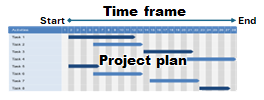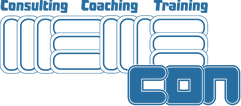Conceptualize Landingpage
Determine topic
Trigger
- Mission/ Assignment/ Desire
A task is envisaged generally, explicitly or non-bindingly. - Brainstorming
The topic unfolds from open, team-oriented thinking. - Situation/ Problem
Current circumstances require alternative solutions. - Interest
Curiosity sparks the urge to explore new topics.
Select topic
If different topics are found, the joint prioritization
and choice determine the subject selection of the subsequent quest.
and choice determine the subject selection of the subsequent quest.
Determine context
Context
The environment consists of:
- Politics
e.g. political direction, stability and ideology/ leadership style - Economy
e.g. employment rates, economic growth/ shrinkage - Society
e.g. diversity, education, cultural norms - Technology
e.g. technological change, emerging technologies, R&D - Law
e.g. laws, regulations & standards - Environment
e.g. climate change, sustainability, disasters and natural events
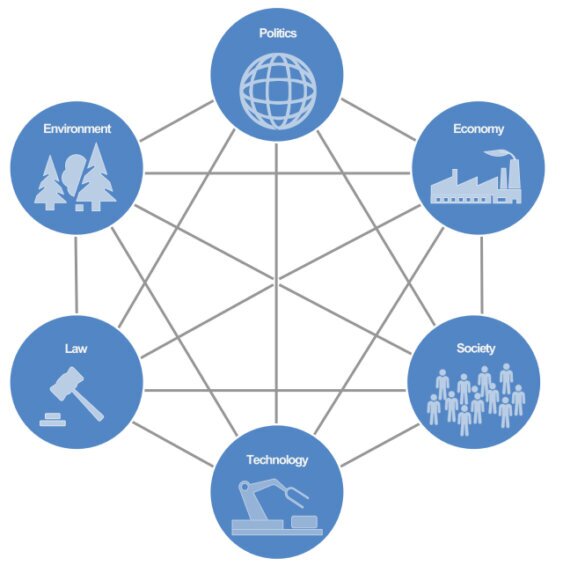
Find Questions
W-Questions
W-Questions
Open questions provide the best results: Who? What? When? Where? Why?
Question aspects
Possible aspects of the topic are expectations, strategies, activities, results, (missed)successes and the like - in the past, present and future.
A good querying
is clear, has a purpose, is tailored to a context, with defined assumptions and open regarding the results.Choose three top questions
Prioritization
In the interest of usable results, a maximum of three questions are processed. The selection can be based on the following criteria:
- Strategic relevance, e.g. long-term goals
- Customer needs, e.g. customer demand, satisfaction and loyalty
- Economic benefit, e.g. increase in sales, cost reduction, ROI
- Deadline pressure, e.g. binding dates, fuzzy intentions, flood of orders
- Availability of resources, e.g. people, technology, material, finances
- Innovation potential, e.g. new services, structures, attitudes
- Synergies, e.g. improving the distribution of tasks, processes or cooperation
- Risk management, e.g. minimizing risks, rectifying disruptions, coping with disasters
Be inspired
Digging up ideas
Our experiences create memories that are found in our deep structure with a skillful approach. Ideas are found in exchange with colleagues. The following iterative process uses a book for inspiration.
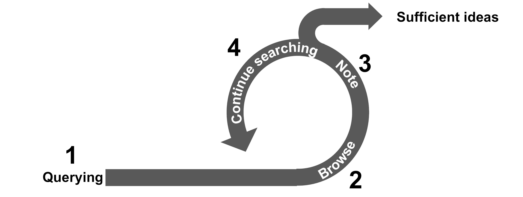
- Make yourself aware of the querying.
- Browse at random through the book and let yourself roam across the pages - the pictures, unfortunately only German headings and texts.
- Write down on Post-its actions, results and consequences that come to mind and check whether you already have enough ideas.
- Repeat steps 1-3 until you noted enough ideas.
Summary
Evaluation
Within 45 minutes a long list of associations should be available, which are clustered, evaluated and limited to 7+-2 clusters.
- Clustering
Collect and cluster similar ideas into a topic bundle. - 7plusminus2
Usually between five and nine clusters should be formed. If you have more, select the most promising 7+-2.
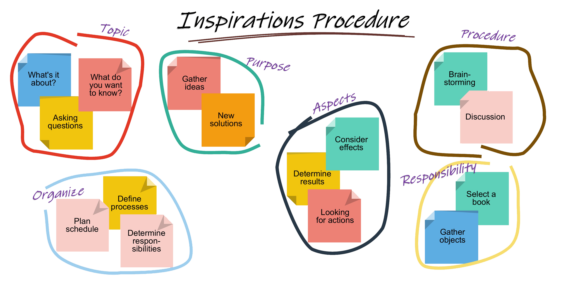
Derive ToDos
Collect ToDos
For the 7+-2 cluster ToDos are now detected. A ToDo is a A ToDo is a task that subsequently will be either orchestred with subtasks or combined with others to form a large ToDo.
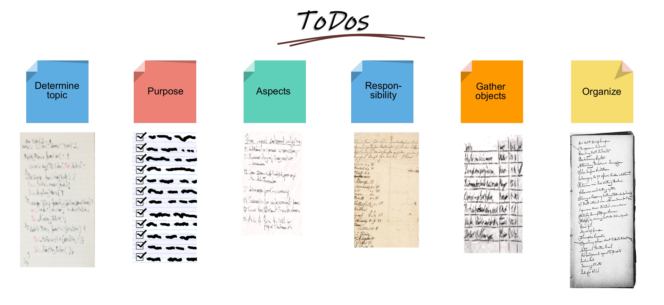
Evaluate ToDos
The ToDos will ensure that you
- support the above topic,
- take place in the above context,
- support the defined querying and
- provide answers to the top questions.
If deviations have crept in, then either
- the ToDos (A) are adjusted or
- the framework conditions (B) (topic, context, querying or top questions) are adapted.
Dislocated tasks prevent effective change.

Organize tasks
Procedure
You can then implement the tasks in the form of a classic project, SCRUM development or OKR journey.
- Classic project
A project is a unique undertaking that is proceeded in phases that build on each other - initialization, definition, planning, controlling and closing. Despite the unpredictability of the procedure, a project is set-up in advance. - SCRUM development
SCRUM follows an iterative framework that promotes self-organization and the adaptability of exec(utives/utor) during realization. The building blocks are defined roles, lean events and simple artifacts. - OKR-Journey
OKR (Objectives & Key Results) is a procedure that focuses on objectives and key results. Therefor objectives are defined for the desired results, dependencies are clarified, clarified and distributed to the managers and executives who realize them.
Choose the approach that suits best the tasks and your organization.
Create schedule
Timeframe
The time frame sets the start and end of the project. The detailed time planning takes place before or during implementation - depending on which approach is chosen.
